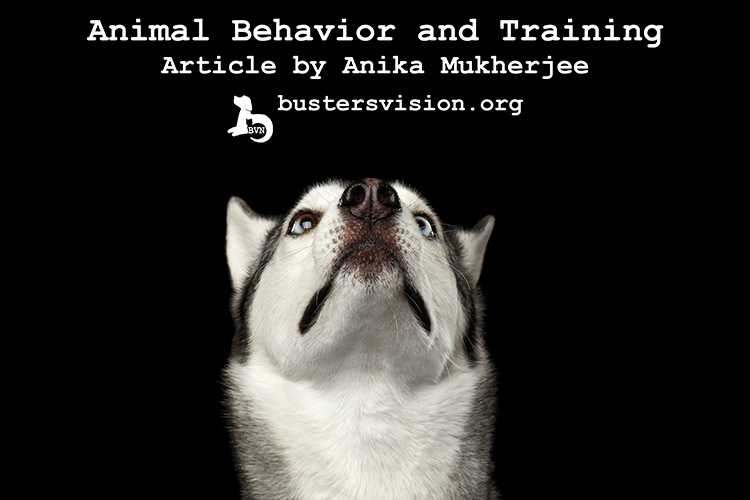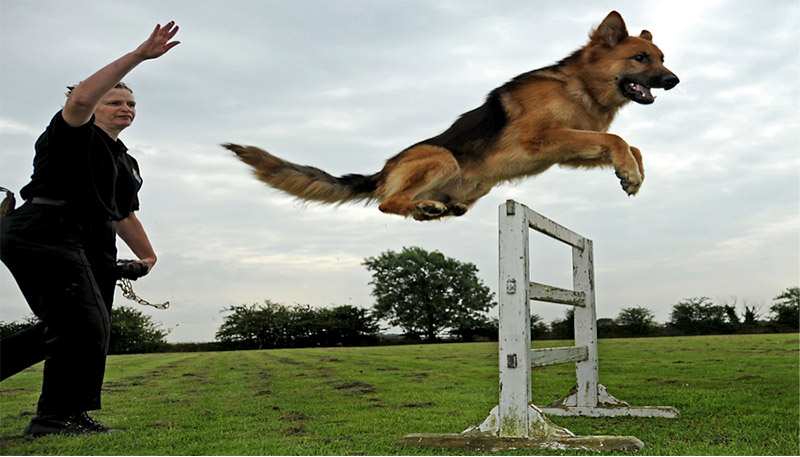animal behavior dog training separation anxiety
Buster’s Vision Education Tool
Animal Behavior and Training
By Anika Mukherjee, Rescue the Mistreated, Save the Injured, Love the Abandoned
Editor, Meet Galuti

Share this Post
The Mysteries of Animal Behavior
Many people freak when their pet exhibits normal behavior for a pet. For a dog, I listed below some normal behaviors:
- Chews things indiscriminately.
- Steals food.
- Barks at intruders.
- Relieves themselves wherever they feel like it.
Aggressive Pet Behavior
It is important to teach your pet to behave; especially a dog. Many aggressive dogs, coined as “Aggro Dogs” can be dangerous to other pets and human beings. (Aggro means aggression, violent behavior. People can have aggro behavior too.)
Unfortunately, when something goes wrong, the dog is blamed for their aggressive behavior. The pet owner should be put to blame for not being responsible for their dog’s aggressive behavior. We take dogs out of their natural environment as wild dogs and domestic their behavior and expect them to adapt to our environment.
“Don’t blame the dog for their aggressive behavior. Blame the pet owner”.With that said, if you have exhausted every remedy to control an aggressive violent dog with no success. The decision must be made to put the pet down before a pet or person is attacked. Do not feel bad or blame yourself. It is not your fault. Many animals are meant to be free and not confined to a domesticated life. (FYI, dogs are known to be pack animals. Many people leave their dog home alone for hours and don’t exercise them, which can cause severe depression and possibly aggro behavior.)
True Story About a Rescue Dog
A dear friend of mine rescued a medium size dog from a kill shelter. His dog was the perfect companion dog for ONLY people. Sadly his dog could not be in the presence of another dog without not wanting to attack with vengeance. My friend spent thousands of dollars on professional trainers with no success in curing his aggressive behavior. Sadly, he could not take his dog to a vet, dog parks, pet stores, etc. Unhappily, he had to walk his dog at odd hours or when people were asleep. He used two collars on his dog for fear a collar would break loose and hurt another dog.
Sadly his pet dog mauled another dog while visiting family. Unfortunately, his pet dog was put-to-sleep. He believes his pet dog was trained as a bait dog prior to his ownership. It was a heartbreaking experience that left his owner in tears as this was his companion dog.
Animal Behavior Training Concepts
Animal Behavior Training Concepts can help you teach and discipline your dog to behave. Of course, humans find some ‘normal’ pet behaviors as highly unacceptable, but they should know it is unfair to expect the pet to intuitively know what unacceptable behavior is in human society. This does not happen by chance and considerable time must be given to training a pet.

Behavior Problems Overwhelming?
Sometimes pet behavior problems seem overwhelming, but many can be managed with the application of a little knowledge and a little effort. I listed below some common dog behavior problems.
1) Aggression:
It’s the number one reason pet owners seek professional help from trainers and veterinarians. A dog that shows aggression to people usually exhibits some part of the following sequence of increasingly intense behaviors:
- Becoming very still and rigid.
- Guttural barks that sound threatening.
- Lunging forward or charging at the person with no contact.
- Mouthing, as though to move or control the person, without applying significant pressure.
- “Muzzle punch” (the dog literally punches the person with her nose).
- Growl.
- Showing teeth.
- Snarl (a combination of growling and showing teeth).
- Snap.
- Quick nip that leaves no mark.
- Quick bite that tears the skin.
- Bite with enough pressure to cause a bruise.
Medical Conditions and Dog Aggression
Some aggressive dogs behave the way they do because of a medical condition or complication. In addition to acute painful conditions, dogs with orthopedic problems, thyroid abnormality, adrenal dysfunction, cognitive dysfunction, seizure disorders and sensory deficits can exhibit changes in irritability and aggression.
If your dog has an aggression problem, it’s crucial to take her to a veterinarian, before you do anything else, to rule out medical issues that could cause or worsen her behavior.
Limit Dog to Triggers for Aggressiveness
In many cases, the only solution is to manage the problem by limiting a dog’s exposure to the situations, people or things that trigger her aggression. There’s always a risk when dealing with an aggressive dog. Pet parents are responsible for their dogs’ behavior and must take precautions to ensure that no one’s harmed. Aggression also changes depending on the breed of your dog. A professional trainer also can help to keep your pet’s aggression via several behavioral training. But individual dogs need different treatment. As an owner makes sure you choose the right option.
2) Barking
Barking is one of many forms of vocal communication for dogs. Sometimes a dog’s barking can be excessive. Because barking serves a variety of functions, you must identify its cause and your dog’s motivation for barking before you can treat a barking problem. Dog barks due to several reasons such as territorial barking, alarm barking, attention-seeking barking, greeting barking, compulsive barking, frustration-induced barking etc. Other problems such as illness, separation anxiety can also cause barking. The first step toward reducing your dog’s barking is to determine the type of bark your dog is expressing.
- When and where does the barking occur?
- Who or what is the target of the barking?
- What things (objects, sounds, animals or people) trigger the barking?
- Why is your dog barking?
For treatment of territorial barking, your dog’s motivation should be reduced as well as his opportunities to defend his territory. To manage your dog’s behavior, you’ll need to block his ability to see people and animals.
If your dog continues to alarm bark or bark territorially, despite your efforts to block his exposure to sights and sounds that might trigger his barking. Teach your dog that when someone comes to the door or passes by your property, he’s permitted to bark until you say “Quiet.” Allow your dog to bark three to four times. Then say “Quiet.” Avoid shouting. “Go to your spot” training also helps to teach your dog a specific set of behavior. Especially when people come to your house, thus reducing alarm barking. If this process does not help, please reach out to a professional trainer.
- Do not encourage your dog to bark at sounds, such as pedestrians or dogs passing by your home.
- Do not punish your dog for barking at certain sounds.
- Never tie your dog’s muzzle closed with rope, cord, rubber bands or anything else. Doing this is dangerous, painful and inhumane.
3) Destructive Chewing
It’s normal for puppies and dogs to chew on objects as they explore the world. Rule out the problem that can cause destructive chewing like separation anxiety, fabric sucking, or hunger.
For reducing puppy chewing some recommendation is to give puppies ice cubes, special dog toys that can be frozen or frozen wet washcloths to chew, which might help the numb teething pain. See the list below for more information:
- Provide your dog with plenty of his own toys and inedible chew bones. Pay attention to the types of toys that keep him chewing for long periods of time and continue to offer those.
- Offer your dog some edible things to chew, like a dog bone. Be sure to consult a vet on dog bones for chewing to protect your dog. Cooked bones or the wrong raw bone can cause splintering.
- Discourage chewing inappropriate items by spraying them with chewing deterrents.
- Provide your dog with plenty of physical exercises (playtime with you and with other dogs) and mental stimulation (training, social visits, etc.).
Do not show your dog the damage he did and scold or punish him after the fact. Also, do not use duct tape to hold your dog’s mouth closed around a chewed object for any length of time. Do not muzzle your dog to prevent chewing.
4) Howling
Dogs howl to attract attention, to make contact with others and to announce their presence. Dog’s excessive howling might be caused by separation anxiety. Separation anxiety howling only occurs when a dog is left alone or otherwise separated from his owner.
Dogs sometimes howl when they’re hurt or sick. If your dog starts howling or howls more than usual, take him to a veterinarian to rule out illness and injury before doing anything else.
Ignore your dog’s attention-seeking howling and reward your fluff for being quiet. You can also try teaching your dog to be quiet when you ask him to. Try to spend, as much time as possible with your dog.
5) Separation anxiety
One of the most common complaints of pet parents is that their dogs are disruptive or destructive when left alone.
Common symptoms of separation anxiety are urinating and defecating, barking and howling, chewing, digging, destruction and also try to escape.
Before attempting behavior modification for separation anxiety, please see your dog’s veterinarian to rule out medical issues.
- If possible, take your dog to work with you.
- Arrange for a family member, friend or dog sitter to come to your home and stay with your dog when you’re not there.
- Take your dog to a sitter’s house or to a doggy daycare.
- Play fun, interactive games with your dog, such as fetch and tug-of-war.
- Take your dog on daily walks and outings.
- If your dog likes other dogs, let him play off-leash with his canine buddies.
Similarly for cat litter box is an essential part. Promote appropriate litter box habit with the following tips:
Location: Offering the cat a visual advantage will ensure he isn’t startled or ambushed by other animals while eliminating. If using his litterbox is an unpleasant, or unsafe event, he will find a new place to go.
No. Of litter boxes: There should be at least one litter box per cat to avoid a problematic situation. Ideally, if you live in a multi-cat household, offer one box per cat plus one.
Keep it clean: Litter boxes should be scooped out twice a day. Once per week the litterbox should be emptied and cleaned with soap and water.
If your cat begins to eliminate in areas other than his litter box, you should first call your veterinarian. Many medical conditions can cause a change in a cat’s litter box habits. If your veterinarian determines that your cat is healthy, the cause may be behavioral. Most litter box behavior problems can be resolved by using behavior modification techniques.

Common cat signs of fear are retreating, hiding, curling up to appear small, raised hair on arched back, ears pinned back, enlarged pupils, inappropriate elimination, hissing, over-grooming, loud crying, anorexia, and aggression.
Before a behavior modification program can begin, you must master some basic training with your cat. This can be accomplished with a harness, leash or crate. Trained cats can respond to basic commands for rewards (e.g. sit, come, give a paw). This takes time and repetition combined with food rewards helps.
Why Train Your Pet?
The life of a well-trained pet is much better than an untrained pet. Training has much more benefit than you think. Trained pets have more freedom, as their behavior is more reliable, and you can take them to more places. Training enables you to choose from among a broad range of activities. Such as dog sports to participate in and enjoy with your dog, such as dog agility, rally-obedience, dancing with your dog, tracking, search & rescue, skijoring, sledding, water rescue trials, obedience, carting, reading programs, therapy work, and a nearly endless range of fun and philanthropic things to do!
No problem in visiting friends and families with a well-trained dog. They can spend more time off leash, which helps to develop their mental stimulation. It’s also good for loyalty and companionship.

Most importantly, not only will obedience training help your dog to become more responsive, but it also enables you to have immediate control over your dog’s behavior, in an emergency situation obedience training may save your dog’s life.
Professional Training Facility Selection
Before giving faith to any training facilities, ask for a tour to meet the needs of your pet. However, every pet is different and their needs may change accordingly. Check whether training group sessions are small and with a high student-teacher ratio. Make sure there are lots of individualized attention and generous support between sessions. There are several types of training for different levels and type of training needed for a specific pet.
Puppy Kindergarten: Puppies less than 18 weeks old need to play with other puppies, meet new people, learn all kinds of new skills, and develop confidence in new situations.
Obedience Courses, Levels 1–4: Obedience Levels 1, 2, and 3 focus on basic obedience (like getting your dog’s attention, jumping up, and walking on a leash), skill building, and managing distractions. Dogs and handlers who complete Level 4 are eligible to take the Canine Good Citizen Test.
Specialty Workshops: Specialty classes include training for more specific skills, like scent detection, reactivity, and tricks. Workshops focus on recalls (“Come”), loose-leash walking and more.
Private Training Sessions: Not all dogs do well in group settings. One-on-one with experienced, professional trainers should be there to help with your pet.
Behavioral Training Cost
The cost of dog obedience training varies; group classes are less expensive than private sessions with professional trainers. Pet owners should ask about what kinds of services are included in the cost before spending money. Local community centers, dog daycare operations, and some pet stores offer group classes that may range from $50 to $125 for four to eight weeks of one-hour sessions. Classes for puppies might cost less than those for adult dogs.
Private classes with a professional trainer range from $30 to $100 per hour, costing about $240 to $600 for six sessions, according to CostHelper. There are also obedience board kennel schools that cost between $1,000 and $2,500. The dog receives one-on-one training for several hours for two to four weeks of training and boarding.
You might also have to pay for training aids, dog treats, noisemakers and leashes to train the dog, which costs less than $50. Dogs with behavioral problems could cost more than $100 an hour.
In conclusion, people who make time to teach their dogs lead more fulfilling lives with their canine companions. A healthy balance of learning manners, encouraging sociability and providing your pet with the right kind of outlets will ensure the success. Having a well-behaved and trained animal is a joy to both you and your pet!

Sources
- https://www.aspca.org/pet-care/dog-care/common-dog-behavior-issues
- http://www.embracepetinsurance.com/training
- http://www.urbandogtraining.com.au
- http://www.dog-obedience-training-review.com/dog-behavior-training.html
- http://abtconcepts.com/
- https://positively.com/dog-training/find-a-trainer/why-should-i-train-my-dog/
- http://www.newsmax.com/FastFeatures/dog-obedience-training-cost/2015/01/11/id/617892/
